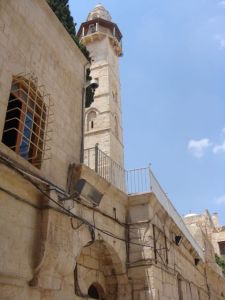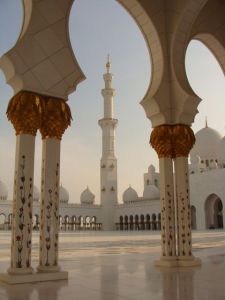One of the things that I noticed several times during visits to very different parts of the Middle East and North Africa were examples of early Muslims, Christians and Jews showing a tolerance for each other that has certainly not been the prevailing theme of more recent years, or at least not the theme of media coverage in more recent years. One such example, in the tomb Morocco’s Moulay Ismail, I mentioned as part of an earlier post. Yet another example I found in the very heart of the current conflict between Jews, Christians and Muslims: Jerusalem.

The Mosque of Omar in Jerusalem, across a small courtyard from the Church of the Holy Sepulchre
So much has happened in Jerusalem, religiously and historically, that current discussions of Palestinian autonomy tread lightly on the subject of dividing or allowing a shared authority in the City itself. However, people would be wise to look backwards at the actions of one of the first Caliphs, Omar, when his Rashidun Army conquered the city in the year 637 AD. The Christian Patriarch Sophranius, upon surrendering, asked as a condition of the city’s capitulation, to be allowed to surrender to the Caliph himself rather than to a military leader. When Omar reached the city, the Patriarch invited him to pray in the Church of the Holy Sepulchre (which is the site of the Cruxifiction, see my separate entry on the subject). Muslims revere Jesus, not as the Son of God, but still as one of the major prophets in the line from Abraham to Muhammad. Many Muslim men are named Issa or Aissa, which is the Arabic equivalent of Jesus. This is not strange. Just as many Muslims are named Daoud or Sulieman after David and Solomon.
Anyway . . . Omar was both sensitive about keeping the Christian Church autonomous and also didn’t want to set a precedent for Muslims to pray at the Church of the Holy Sepulchre. So he prayed, with Sophranius, just a few feet away at a spot where King David was said to have prayed. Omar then built a mosque on the site so that future Muslims could pray near to, but not violating, the sacred Christian site.
Even more telling, at the Church of the Holy Sepulchre, is that the church itself has been divided into seven different areas of responsibility, parceled out to seven different Churches (Eastern Orthodox, Armenian Apostolic, Roman Catholic, Greek Orthodox, Coptic Orthodox, Ethiopian Orthodox and Syriac Orthodox). But the keys to the building itself are held by a Muslim family, so as not to cause jealousy among the seven!
This is, truly, an elegant solution. Though it might seem Not Quite Right to entrust the opening and closing of Christianity’s most important church to a non-Christian, such a solution might be best for the city as a whole. Maybe a battalion or two of Buddhist peace keepers could be found to enforce whatever solution is finally decided upon for the Holy City.





